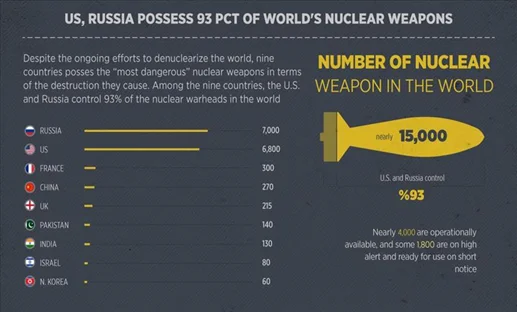International Relations
Context: There has been much buzz and considerable apprehension at the international level about the use of nuclear weapons as a result of the Russia – Ukraine conflict.
About nuclear weapons:
- A nuclear weapon is a device designed to release energy in an explosive manner as a result of nuclear fission, nuclear fusion, or a combination of the two processes.
- Fission nuclear weapons.
- These weapons are based on the fission reaction and are commonly referred to as atomic bombs.
- They release energy in a more controlled manner.
- Fusion nuclear weapons:
- Fusion weapons are based on fusion reactions (i.e., combination of two or more nuclei).
- They are also referred to as thermonuclear bombs or, more commonly, hydrogen bombs.
- They release more and uncontrolled energy vis-a-vis fusion weapons.
Status of nuclear weapons:
- Nuclear weapons have only been used twice in warfare—in the bombings of Hiroshima and Nagasaki in 1945 during the World War-II.
- However, it is estimated that over 13,000 nuclear weapons are in existence as of today.
- The United States and the Russian Federation account for about 90% of the nuclear weapons.
- It is also estimated that there have been over 2,000 nuclear tests conducted to date.

International Laws on the use of nuclear weapons:
- Nearly 30 years ago the International Court of Justice tendered its Advisory Opinion to the UN on the question of the “threat or use of Nuclear Weapons in any circumstance permitted under International law”.
- A majority of 12 out of 15 judges upheld “that humanitarian law has to be read subject to an exception.”
- It permitted a State to use nuclear weapons in self-defence when its survival was at stake, even where such use would otherwise be a breach of humanitarian law.
- It was deep rooted in many ancient cultures — Buddhist, Chinese, Christian, Islamic and traditional African.
- Each of these cultures had given expression to a variety of means that can be used for the purposes of fighting one’s enemy and problem.
- They cited that the ancient South Asian tradition prohibited the use of “hyper destructive weapons”.
Global initiatives to prevent use of nuclear weapons:
Partial Test Ban Treaty (PTBT)
- It prohibits testing of nuclear weapons in the atmosphere, underwater, and in outer space.
- However, it permits nuclear test explosions underground.
Comprehensive Nuclear-Test Ban Treaty (CTBT):
- It curbs the development of new nuclear weapons and the improvement of existing nuclear weapon designs.
- Once it enters into force, it will be legally-binding against nuclear-testing.
- CTBT does not explicitly define nuclear weapons and nuclear explosive devices
- Treaty for the Non-proliferation of nuclear weapons
- It seeks to inhibit the spread of nuclear weapons.
- It came into existence in 1970s and has 191 members including the Permanent five (P-5)
- India refused to sign it on the grounds that the nuclear weapons states must agree to a clear plan for nuclear disarmament.
Treaty on Prohibition of nuclear weapons (TPNW):
- It is based on Humanitarian Initiative led by a group of non-nuclear weapons states who advocate nuclear disarmament on humanitarian grounds
- It legally binds and prohibits member states from developing, testing, producing, manufacturing, acquiring, possessing, or stockpiling nuclear weapons or other nuclear explosive devices
- India is not a member of TPNW as it was not part of its negotiations.
Nuclear Suppliers Group (NSG):
- It is a consensus-driven group of nuclear supplier countries that seek non-proliferation of nuclear weapons through the implementation of “Non-Proliferation Principles” for nuclear exports and nuclear-related exports
- It was formed in 1974 in response to India’s nuclear test.
- India is not a member of the NSG as it is opposed by China on the basis of NPT non-signatory status of India.
India’s stand on nuclear weapons
- After its first nuclear explosion in 1974, India argued that it was committed to the policy of using nuclear power only for peaceful purposes.
- India has neither used nuclear weapons nor threatened any state; it has always advocated nuclear weapons only as a means of deterrence.
- After the 1998 nuclear test India also enunciated a doctrine of ‘No First Use’ (NFU) of nuclear weapons.
- The NFU doctrine was formally adopted in January, 2003.
Way Forward:
- All countries whether nuclear or non-nuclear must adapt to a nuclear-free world.
- As per J Robert Oppenheimer (inventor of the atom bomb), the only defence against a nuclear weapon is peace.
- The need of establishing peace has also been highlighted in the preamble of UNESCO that says “Wars begin in the minds of men, and it is in the minds of men (and women) that the defences of peace must be constructed.”
Therefore, the global leadership should ensure that the nuclear weapons – for as long as they continue to exist – should serve defensive purposes, deter aggression, and prevent war.
Source: Indian Express














